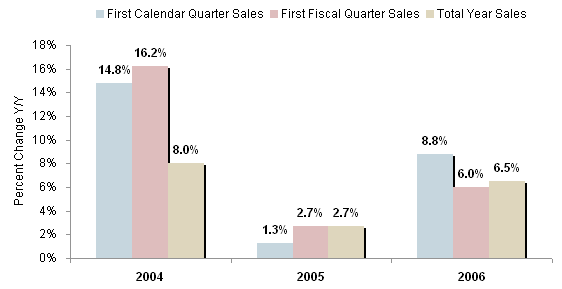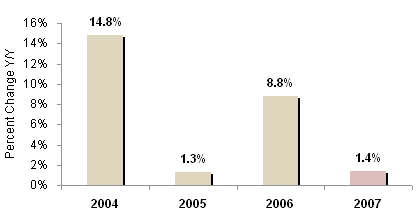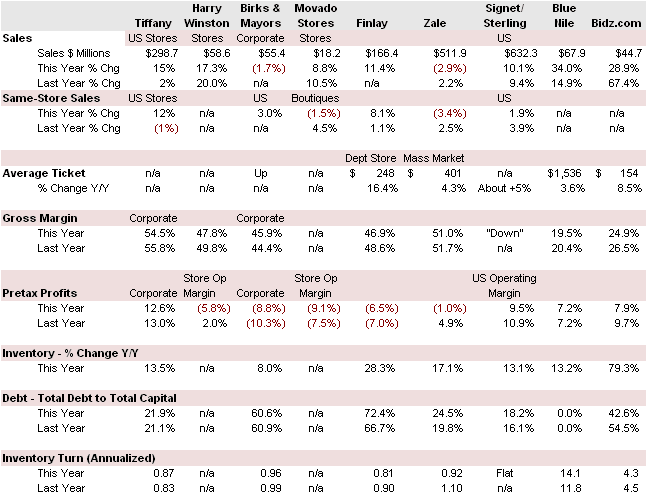IDEX Online Research: U.S. Jewelry Sales & Profits Under Pressure in Q1
June 24, 07
The tide comes in; the tide goes out. – Merchants’ proverb.
For U.S. jewelers, 2006 was a banner year, with the tide running high. Jewelry sales soared by 7.1 percent over the prior year. Unfortunately, 2007 is not starting out strongly; the tide is dropping.
If current trends continue, 2007 will likely be one of the weakest years in the decade.
The Good News: The First Quarter Is Not Particularly Important
For most specialty jewelers, the first quarter is not particularly important. For those jewelers who report results on a calendar quarter, first quarter sales are about 20 percent of total year sales.
For jewelers on a fiscal first quarter – February, March, April – the first quarter represents about 21 percent of total annual sales. This slight sales mix shift between the calendar and fiscal quarter is because January is less important than April.
While the first quarter is not “important” in terms of its proportion of annual sales, it is important in that sales trends in the period often set the pace for the rest of the year. The graph below compares first quarter sales for 2004, 2005, and 2006, on both a calendar and a fiscal basis, with total annual sales trends for the full year. There is a high correlation between first quarter sales trends and sales trends for the full year.
| First Quarter Sales Set The Tone for the Year |
First Quarter 2007 Sales Trends Weak
Most specialty jewelers reported that their sales were under pressure in the first quarter of 2007. While some jewelers reported strong results – notably higher-end merchants such as Tiffany and Harry Winston – most jewelers said it was more difficult to generate sales in the first quarter.
First quarter sales were affected by three key factors:
- Store traffic declined – Most jewelers said that their store traffic was down in the first quarter versus the same period last year. Valentine’s sales were not particularly strong.
- Fewer transactions – Even high-end jewelers reported that the number of sales transactions declined. Most jewelers claimed that the conversion rate (browsers-to-buyers) held about steady, year-to-year.
- Higher average ticket – Almost every jeweler noted that the only good news was that the average ticket rose. Two factors generated a higher average ticket: 1) greater sales of better quality, larger diamonds; and 2) gold jewelry which now carries a higher average ticket because of the rising price of gold.
The U.S. Department of Commerce reported that specialty jewelers’ sales rose by a very modest 1.4 percent in the first calendar quarter of 2007 versus the same three-month period in 2006, as the graph below illustrates.
| First Calendar Quarter Jewelry Sales Trends |
The graph also illustrates that “the tide comes in and the tide goes out.” In 2004 and 2006, the first quarter sales periods were very strong; in 2005 and 2007, the first quarter sales periods were very weak.
Diamond Sales Remain Strong
Diamonds remain a girl’s best friend; most jewelers reported that their diamond sales were strong in the first quarter of 2007. Bridal demand is largely driving diamond sales, according to most merchants. Here are the top three sales categories for jewelry in the first quarter:
- Diamond jewelry
- Colored gemstone jewelry (including jewelry with diamonds and other gems)
- Watches
Gross Margins Decline in First Quarter
Almost every publicly held specialty jeweler, except for Birks & Mayors, reported that their gross margin fell in the first quarter. Even those few jewelers who reported relatively strong sales gains experienced a decline in their gross margin. Clearly, sales leverage was insufficient to absorb some of the relatively fixed costs which are included in the cost-of-sales calculation (which yields “gross margin”).
We estimate that specialty jewelers’ gross margins fell by about one percentage point (100 basis points) in the first quarter of 2007 versus the same period last year.
Almost every jeweler noted that they were unable to pass along the full amount of higher commodity prices – particularly gold, silver, platinum – in their retail prices. Most jewelers also said that they made “price adjustments” (read: price increases) in the first quarter, but those price increases were generally made after the Valentine’s selling period, so they affected only a small portion of the quarter.
Expenses Holding
Most jewelers attempted to offset lower gross margins by cutting expenses. In general, they were successful.
However, far too many jewelers reported that they had cut back on sales associates’ hours in the store. In the long term, that is a killer strategy: it will kill a retailer. While sales salaries are one of the easiest expense categories to reduce, sales associates are the foot soldiers of the army. Without adequate soldiers fighting for market share, jewelers will lose the war to other merchants who maintain or increase sales people when the going gets tough.
Pretax Margins Deteriorate
Gross margins were down in the quarter, but the decline was somewhat offset by reduced expenses. Interest expense was slightly higher, and other expenses were generally flat. Thus, most jewelers reported only a small deterioration in their pretax margin.
We estimate that jewelers’ pretax margins fell by about six-tenths of one percentage point in the first quarter of 2007 versus the same period last year.
Inventory Levels Up; Inventory Turns Down
As a result of generally weaker-than-expected sales levels in the first quarter, jewelers’ inventory turns slowed modestly. Jewelers had expected higher sales, and they had brought in enough inventory to fill their projected demand trends. When sales failed to materialize, they were left with higher levels of unsold inventory.
The jewelry industry has one of the lowest inventory turns of any retail category. In the first quarter, we estimate that jewelry industry inventory turns fell from about 1.0x turns annually to about 0.9x turns annually. The range for inventory turns for most retail categories is 3.0x-5.0x annually.
Debt Levels Up
Primarily as a result of higher inventory levels and lower cash levels, both of which are related to below-plan sales, jewelers report that their debt levels are up moderately. As a result of higher debt levels, coupled with slightly higher interest rates, profits were adversely affected in the quarter.
Summary: Financial Pressures Mount in First Quarter
The following table summarizes the financial results of major publicly held companies.
| First Quarter 2007 - Retail Financial Results - Key Public Companies |
Outlook: Conservative
Virtually every jeweler mentioned the “uncertainty” in the market: what will the economy do? What will precious metals prices do? Will the consumer continue to spend? What will the slower housing market mean? When will consumers step up their savings rate? Will stock market volatility have a negative impact on jewelry demand? And the questions go on and on.
In our opinion, “uncertainty” is a euphemism for “pessimism.”
Jewelers say they are planning for only “modest” to “moderate” gains for the balance of 2007, including the all-important holiday selling season.
The reported decline in traffic at the Las Vegas JCK jewelry show in June reflected some of the uncertainty in the industry. While some vendors reported strong sales, many of those sales were to overseas customers from the Middle East and Asia.
IDEX Online Research continues to predict that jewelry sales in the U.S. will rise by 3-4 percent in 2007, down from last year’s very strong 7.1 percent gain, as the graph below illustrates. It won’t be a banner year, but it won’t be a bust, either.
| U.S. Jewelry Sales |



